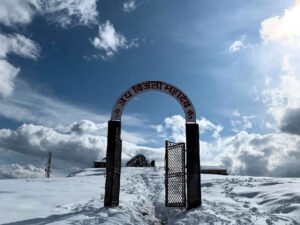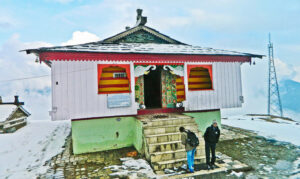Bijli Mahadev Temple: A Spiritual Haven in the Himalayas
Nestled amidst the pristine beauty of the Himalayan ranges in Himachal Pradesh, India, lies a sacred pilgrimage site that beckons both the devout and the wanderer alike. Bijli Mahadev Temple, perched at an altitude of 2,460 meters (8,070 feet) above sea level, offers not only a spiritual retreat but also breathtaking vistas of the Kullu Valley. This ancient temple, dedicated to Lord Shiva, is steeped in legend, natural wonder, and the serene ambiance that only the Himalayas can provide.

A Glimpse into Mythology
The legend surrounding Bijli Mahadev Temple is as captivating as the temple itself. According to local folklore, the temple enshrines a tall staff that attracts divine lightning strikes. The term “Bijli” translates to lightning in Hindi, and it is believed that the tall staff, or “Lingam,” situated inside the temple gets shattered into pieces by lightning every year. The priests at the temple then use butter and sattoo (powdered roasted gram) to put the lingam back together. This annual ritual symbolizes the union of Lord Shiva and his consort, Parvati.
Journey to Bijli Mahadev

The journey to Bijli Mahadev Temple is an experience in itself. It begins from Kullu or Manali, with a drive to the village of Chansari, followed by a moderate trek of approximately 3 kilometers (1.86 miles). The trek winds through dense pine forests, offering glimpses of the snow-capped peaks in the distance and the gurgling Beas River flowing below. During winters, the temple is often covered in a blanket of snow, adding to its mystical allure.
As you ascend towards the temple, the air becomes crisper, and the sound of the forest gives way to a profound silence broken only by occasional bird calls and the rustling of leaves. The path, although not overly strenuous, requires a steady pace and rewards the trekker with panoramic views of the surrounding valley and mountains.
Architectural Marvel and Serenity
The Bijli Mahadev Temple itself is a modest structure made of wood and stone. in traditional Himachal architectural style. The temple courtyard offers a serene environment for meditation and reflection, with ancient stone carvings and prayer flags fluttering in the mountain breeze. Inside the sanctum sanctorum, devotees find themselves in the presence of the lingam, adorned with flowers and surrounded by offerings of incense and ghee lamps.
The temple’s location provides a stunning vantage point to witness the changing hues of the sky during sunrise and sunset. Many visitors choose to spend a night near the temple to witness the ethereal sight of moonlit mountains and stars twinkling in the clear Himalayan sky.
Spiritual Significance and Cultural Heritage

For centuries, Bijli Mahadev Temple has been a center of religious and cultural significance for the local communities. Pilgrims from all over India visit to seek the blessings of Lord Shiva and experience a sense of spiritual renewal. The temple is particularly revered during the Shravan month (July-August) when devotees undertake the arduous journey to offer prayers and seek divine blessings.
The cultural heritage associated with Bijli Mahadev extends beyond its religious aspects. Local festivals such as Shivratri are celebrated with great enthusiasm, featuring traditional music, dance, and rituals that highlight the rich cultural tapestry of the region. Visitors have the opportunity to immerse themselves in the vibrant traditions and hospitality of the Himachali people during these festive occasions.
Ecological Conservation and Responsible Tourism
In recent years, Bijli Mahadev Temple has gained recognition not only for its religious and cultural significance but also for its importance in ecological conservation. Efforts are underway to promote sustainable tourism practices and preserve the pristine natural environment surrounding the temple.
Conclusion
Bijli Mahadev Temple stands as a testament to the spiritual legacy and natural splendor of the Himalayas. Its tranquil surroundings, ancient rituals, and panoramic vistas offer visitors a unique opportunity to connect with both nature and divinity. Whether you seek spiritual solace, cultural immersion, or simply wish to marvel at the breathtaking beauty of the Himalayan landscape, Bijli Mahadev Temple promises an unforgettable experience that transcends time and leaves a lasting impression on the soul.
As you contemplate the ancient lingam, pieced together each year amidst the thunderous echoes of divine lightning, you cannot help but feel a sense of awe and reverence for this timeless sanctuary in the heart of the Himalayas.
The Best Part Of The Story
Bijali Mahadeva Mandir is a located in Kashari village, Kullu Valley in the Indian state of Himachal Pradesh. It is located at an altitude of about 2,460m in the Kullu Valley. Bijli Mahadev is one of the ancient temples in India and dedicated to Lord Shiva. Located 14 km from Kullu across the Beas River, it can be approached by a rewarding trek of 3 km. A panoramic view of Kullu and Paravati valleys can be seen from the temple. The 60 feet high staff of Bijli Mahadev temple glistens like a silver needle in the sun. In this temple of lightning, it is said that the tall staff attracts the divine blessings in the form of lightning. Every 12 years, the Shiv lingam is struck by lightning which causes the lingam to break into pieces. The priest then wraps the broken lingam with butter and after few days the lingam becomes as it was.
Trek Details
The Bijli Mahadev to Naggar trek is classified as a trek of moderate difficulty . For two days, you will cover a distance of 16 km.
The temperature of Bijli Mahadev Temple Trek remains pleasant most of the year, as you will rarely find an extremely hot climate here. The average temperature remains between 25 degrees Celsius and 37 degrees Celsius.
The mountain of Bijli Mahadev is believed to be formed from the body of a dead demon.
Lord Shiva asked the devil to look back as his tail caught fire. As soon as he looked back, the Lord struck the demon with his mighty Trishul, which shattered the demon’s body into many parts.
